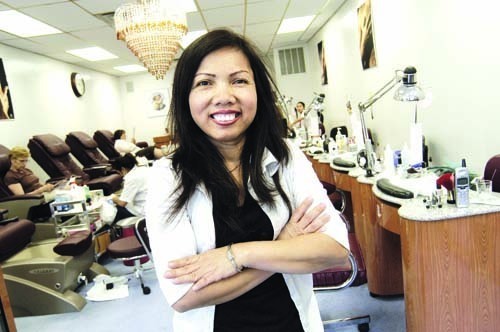
When Channevy “Lilly” Men moved to Rhode Island from Cambodia in 1996, she didn’t have much of a choice in how she could make a living.
In Cambodia she had been a geometry teacher, but because there were no computers to keep records of her employment or degree, her experience meant nothing here.
Besides that, Men didn’t speak English well enough to apply for teacher positions, so she took a job as a parts inspector for a manufacturing company in Cranston while taking English classes at the International Institute of Rhode Island.
“I wanted to go back to school,” she said. “But to spend four years in college with two children to take care of, I thought, how can I afford to go to school?”
Men chose to to study to be a manicurist, because it only required 300 credit hours and she could go to school while continuing to work.
After working for a nail salon on the East Side for about six years, Men opened her own nail salon, Angel Nails, at 15 South Angell St., last August.
Men is one of a small number of Southeast Asian business owners in Rhode Island, though there are about 10,000 Southeast Asians living in the state. Cambodians make up about 47 percent, Laotians 33 percent, Hmong 12 percent, and Vietnamese 9 percent.
As of 2002, there were 1,529 Asian-owned businesses in Rhode Island, according to the U.S. Census Bureau – but those include Chinese, Indian and other Asians and Asian-Americans as well. Altogether, Asians owned 2 percent of businesses in the state as of 2002.
Little is known about them – in part because Southeast Asian business owners typically don’t use state resources such as the R.I. Small Business Development Center.
The RISBDC, which offers business counseling and workshops to small business owners, counseled eight Asians from July 2006 to March 2007, according to the agency’s client data. By comparison, the agency counseled 81 Hispanics.
Sixcia Devine, RISBDC’s regional director for Providence, said she thinks it’s because people in the Southeast Asian community end up getting information on their own, by asking members of their community who have started businesses.
“They go right to the source,” she said. “They find out what steps were taken … then they go right to the Secretary of State’s office, or right to an attorney.”
Men did get advice from the RISBDC, and she also got a loan through the Rhode Island Coalition for Minority Investment, supplementing a loan from her family.
Pich Chhoeun, former president of the Cambodian Society of Rhode Island, said one thing he has observed is that most Southeast Asians use money from friends or family, not from banks, to finance their businesses.
“The people who open the businesses, they don’t speak very good English,” he said. “It’s out of sheer determination they open a business.”
And there are virtually no business associations or economic development efforts catering to the Southeast Asian population, at least none that Chhoeun has seen.
“I personally think there’s a strong need,” he said. “I think if there is something like that in place, I think there will be more businesses from the Southeast Asian community.”
Most Southeast Asians came to Rhode Island between 1975 and 1988, fleeing bloodshed in Cambodia, Vietnam and Laos.
Men said she came here to raise her children away from the political corruption in Cambodia.
Now her main objective is to pay off her debts.
And though she worries about making ends meet, Men said, “I feel happy … I work for myself.” •












